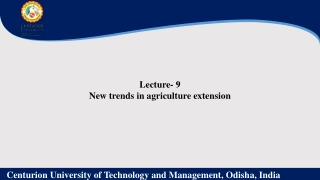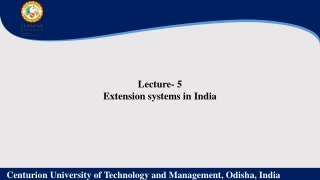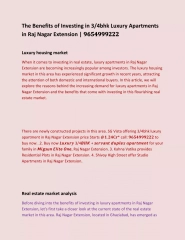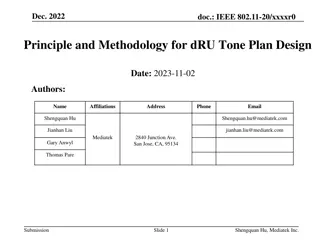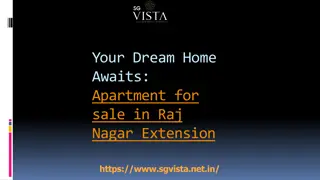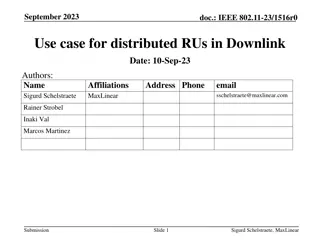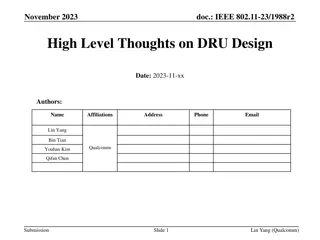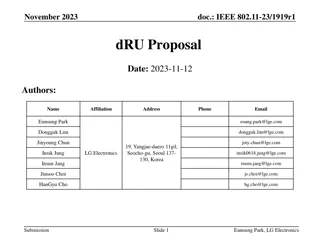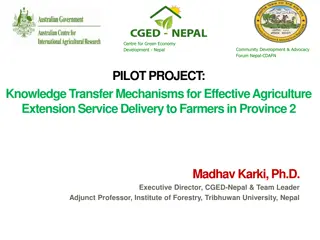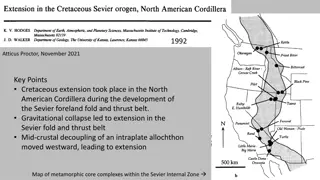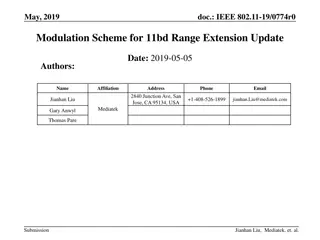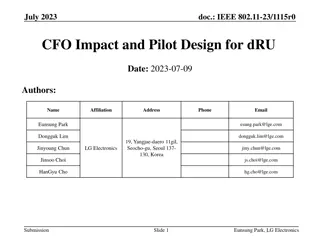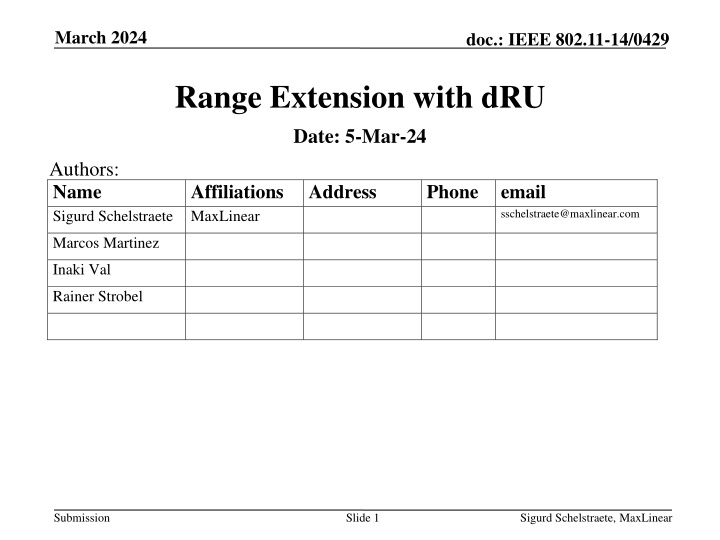
Achieving Range Extension with Distributed RU in IEEE 802.11-14
Explore the potential of Distributed RU (dRU) for range extension in IEEE 802.11-14 standard. Understand how legacy preamble and data field considerations play a crucial role in maximizing the power boost for effective range extension. Delve into the power constraints, allowed power under PSD, and additional preamble requirements for optimal performance. Illustrations provide insights into TB PPDU with regular RU and dRU configurations, shedding light on key design considerations.
Download Presentation

Please find below an Image/Link to download the presentation.
The content on the website is provided AS IS for your information and personal use only. It may not be sold, licensed, or shared on other websites without obtaining consent from the author. If you encounter any issues during the download, it is possible that the publisher has removed the file from their server.
You are allowed to download the files provided on this website for personal or commercial use, subject to the condition that they are used lawfully. All files are the property of their respective owners.
The content on the website is provided AS IS for your information and personal use only. It may not be sold, licensed, or shared on other websites without obtaining consent from the author.
E N D
Presentation Transcript
March 2024 doc.: IEEE 802.11-14/0429 Range Extension with dRU Date: 5-Mar-24 Authors: Name Sigurd Schelstraete MaxLinear Affiliations Address Phone email sschelstraete@maxlinear.com Marcos Martinez Inaki Val Rainer Strobel Submission Slide 1 Sigurd Schelstraete, MaxLinear
March 2024 doc.: IEEE 802.11-14/0429 Introduction Distributed RU (dRU) has been positioned as a way to achieve range extension Most of the focus has been on the power boost that can be achieved in the data field Relative to regular RU However, in order to achieve range extension both the legacy preamble and the data field need to be considered At range, legacy preamble errors and misdetection can dominate Power boost in Data Field may not translate directly into range extension without corresponding improvement in (legacy) preamble power or detection probability We need to confirm that legacy preamble will not be a bottleneck when using dRU Submission Slide 2 Sigurd Schelstraete, MaxLinear
March 2024 doc.: IEEE 802.11-14/0429 Allowed Power under PSD constraint (e.g., -1 dBm/MHz) Max power for dRU is function of the number of tones in the dRU and the spreading BW: Spreading BW NRU rRU 2.08 5.09 8.18 11.77 14.78 17.91 20 40 80 160 13.15 16.16 19.25 19.83 19.83 20.53 26 52 106 242 484 996 10.14 11.39 11.47 N/A N/A N/A 13.15 13.15 14.48 14.39 N/A N/A 13.15 16.16 16.24 16.82 17.40 N/A Power values in dBm Max power for legacy preamble is ? + ?? ????? ????? dBm, with ????? = spreading BW Ideally, power of data field and power of preamble should match Submission Slide 3 Sigurd Schelstraete, MaxLinear
March 2024 doc.: IEEE 802.11-14/0429 Additional Preamble requirements for (EHT) TB PPDU Where to send legacy preamble (36.3.4) Power of legacy preamble and Data (36.3.11.4) i.e., power of non-EHT modulated fields is not higher than power of EHT modulated fields We ll assume that the same rules apply for dRU Submission Slide 4 Sigurd Schelstraete, MaxLinear
March 2024 doc.: IEEE 802.11-14/0429 Illustration of TB PPDU with regular RU The pre-EHT modulated fields are sent on the 20 MHz channels where the STA s EHT modulated fields are present. (802.11be, 36.3.4) Submission Slide 5 Sigurd Schelstraete, MaxLinear
March 2024 doc.: IEEE 802.11-14/0429 Illustration of TB PPDU with dRU Again assume that The pre-EHT modulated fields are sent on the 20 MHz channels where the STA s EHT modulated fields are present. i.e., across spreading BW Submission Slide 6 Sigurd Schelstraete, MaxLinear
March 2024 doc.: IEEE 802.11-14/0429 Allowed Tx Powers for TB PPDU (EHT and non-EHT modulated fields) Higher power in Data Field allows boost in preamble (per EHT standard) Max power allowed in preamble actually slightly higher than power allowed in dRU Spreading BW NRU rRU 2.08 2.08 5.09 5.09 8.18 8.18 11.77 11.77 14.78 14.78 17.91 17.91 20 40 80 160 13.15 21.04 16.16 21.04 19.25 21.04 19.83 21.04 19.83 21.04 20.53 21.04 Data Field Preamble Data Field Preamble Data Field Preamble Data Field Preamble Data Field Preamble Data Field Preamble 10.14 12.01 11.39 12.01 11.47 12.01 N/A N/A N/A N/A N/A N/A 13.15 15.02 13.15 15.02 14.48 15.02 14.39 15.02 N/A N/A N/A N/A 13.15 18.03 16.16 18.03 16.24 18.03 16.82 18.03 17.40 18.03 N/A N/A 26 52 106 242 484 996 Power of legacy preamble limited to power of data field (per EHT standard) Not a direct regulatory constraint Power in preamble likely limiting factor for range Submission Slide 7 Sigurd Schelstraete, MaxLinear
March 2024 doc.: IEEE 802.11-14/0429 Intermediate Conclusion (Legacy) Preamble power is impacted by both regulatory and standard constraints Standards constraint is the most stringent for small RUs The dRU power boost in the Data Field allows boosting the power of the legacy preamble Per EHT Standard Both legacy preamble and the data field are improved, as required for range extension Submission Slide 8 Sigurd Schelstraete, MaxLinear
March 2024 doc.: IEEE 802.11-14/0429 Additional power benefit at receiver (AP) Previous illustrations only discuss transmit power for a single TB PPDU Response to a Trigger frame typically involves multiple simultaneous TB PPDUs, with the (legacy) preambles adding up coherently at the receiver (AP) See illustrations on next slides Submission Slide 9 Sigurd Schelstraete, MaxLinear
March 2024 doc.: IEEE 802.11-14/0429 Multiple TB PPDU arriving at receiver (illustration for RU26) Each RU26 contributes a 20 MHz legacy preamble Legacy preamble are coherent transmissions Additional preamble SNR boost of ??????? ? at receiver N = # RUs in 20 MHz N=9: =9.5 dB N=4: =6 dB Submission Slide 10 Sigurd Schelstraete, MaxLinear
March 2024 doc.: IEEE 802.11-14/0429 Multiple TB PPDU arriving at receiver (illustration for dRU26) Each dRU26 contributes an 80 MHz legacy preamble Legacy preamble are coherent transmissions Additional preamble SNR boost of ??????? ? at receiver N = # RUs in 80 MHz N=37: =15.7 dB N=16: =12 dB Submission Slide 11 Sigurd Schelstraete, MaxLinear
March 2024 doc.: IEEE 802.11-14/0429 Conclusion For good range extension, the following criteria need to be satisfied SNR Boost in Data Field Power Boost in Legacy preamble Efficient use of spectrum If the EHT rules for TB PPDU are followed, the power boost for dRUs benefits the legacy preamble as well Simultaneous reception of multiple TB PPDUs may further enhance detection probability of legacy preamble The three range extension criteria appear to coincide favorably for the case of UL OFDMA with dRU For range extension, the focus of dRU should be on UL OFDMA Submission Slide 12 Sigurd Schelstraete, MaxLinear

